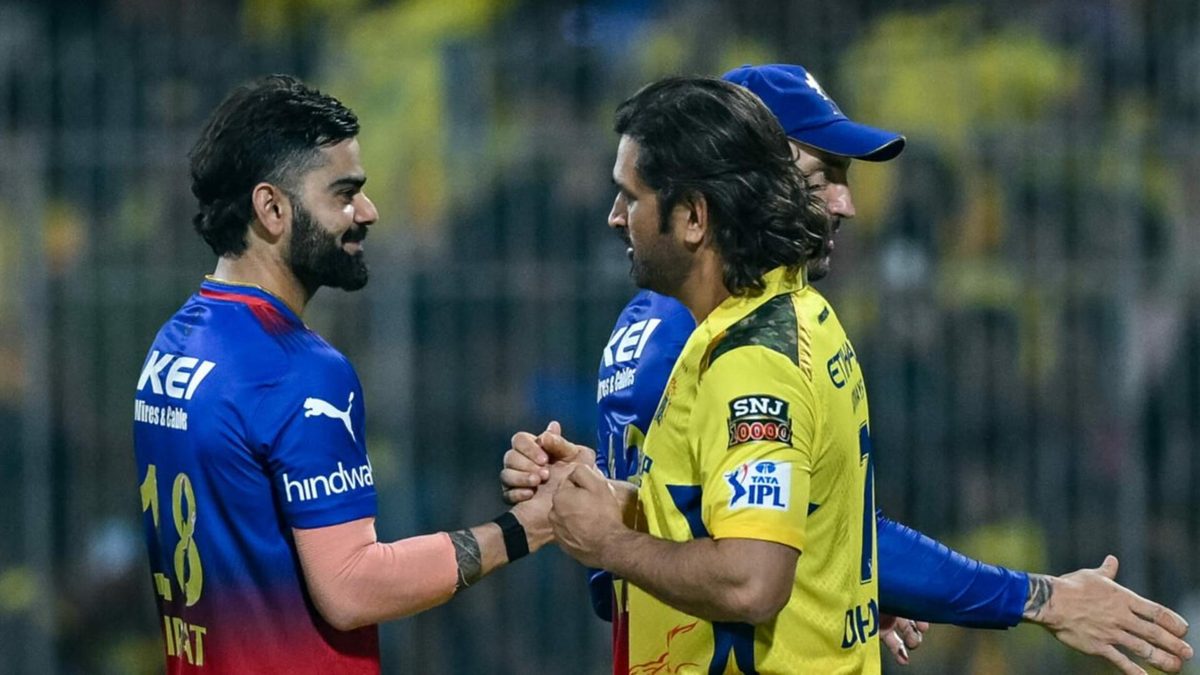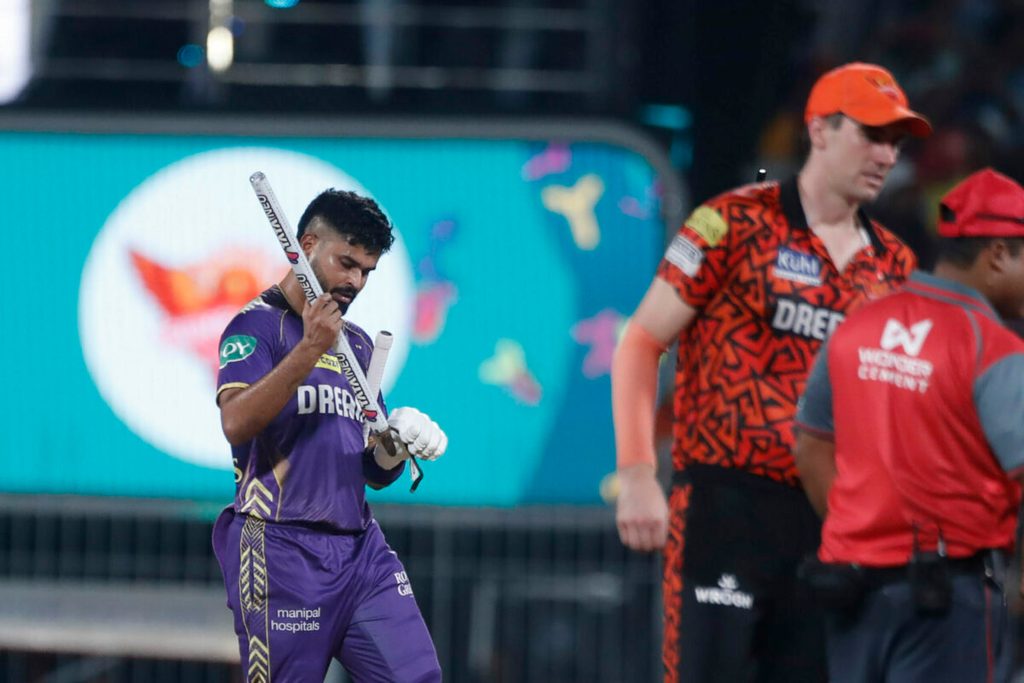
The 17th edition of the IPL concluded with the most one-sided final ever between KKR and SRH, amid chants of CSK from the crowd. Aadya Sharma, at the venue, wonders how a tournament, that focusses so much on its megastars, runs the risk of not adapting with time.
It’s 10.15pm. You’ve made your way to the F Upper block of the Chepauk Stadium, looking to capture Kolkata Knight Riders’ imminent victory moment. The requirement is in single digits, when the crowd erupts into unified chanting.
But it’s not to celebrate KKR.
“CSK… CSK!”.
It’s been over a week since the Chennai Super Kings – the IPL’s traditional behemoths – have been knocked out of the IPL. It has left the Chepauk Stadium with a major identity crisis: for every Super Kings match, the arena is packed to the brim, but the absence of the yellow team has visibly dimmed the enthusiasm. You see it pre-match along the Victoria Hostel Road, usually bereft of breathing space in a sea of yellow. Wallajah Road doesn’t look right without its usual hue.
It’s spaced out for the final, a subdued mix of purple and orange. The passionate fans have been rocked out of their dream sequence. There is no MS Dhoni at the podium.
The tickets for the three non-final playoff games were out on the 14th of May. By then, CSK still had a good chance of making it to the top four, and ideally Qualifier 2 and the final. No wonder fans would have bought them hoping to see the grand old man’s expected farewell.
The official attendance for the 38,000 capacity stadium stood at 29,225 when Sunrisers beat Rajasthan. For the final, the number went over 33,000.
Unfortunately, they all turned out to watch the most one-sided IPL final ever.
As I stood, surrounded by the rhythmic three-letter chants, I paused for a second to assess the moment. How is a soon-to-be 43-year-old still IPL’s biggest draw? A man who faced 73 deliveries all tournament, an average of 5.2 per match. MS Dhoni’s legacy might forever stay untouched, but it’s also spoiled the public to live with blinders on.
Over an hour later, the stadium is in darkness, with an excruciatingly long wait to kick off the final presentation. Most of the crowd has left, it’s close to midnight. Star Sports have pulled out Dhoni’s numbers from the season and are doing a little package on him.
 KKR and SRH played out the most lop-sided IPL final of all time
KKR and SRH played out the most lop-sided IPL final of all time
Is that all the IPL is about?
To this day, the Super Kings, their arch-rivals Mumbai Indians and fan-favourites Royal Challengers Bengaluru remain the three biggest crowd pullers. No surprise there: these teams house the three biggest names in Indian cricket. Dhoni, Rohit Sharma and Virat Kohli might not be IPL captains anymore, but they still hog mindspace and ad space.
In Bengaluru, Kohli has a scarily disproportionate fan-following in his favour. Most tees have his name on the back, the loudest cheers are reserved for him, he remains at the front-and-centre of the brand’s fan engagement. God forbid he ever misses a match at the Chinnaswamy stadium. Refunds would have to be initiated.
Rohit has been at the heart of Mumbai for over a decade, bringing home a trophy half of those years. His unceremonious removal from captaincy has antagonised a section of the fans, which showed when Hardik Pandya was booed at his own home ground. It’s a deeply entrenched sentiment that can’t be discarded quickly. That they finished last this year only snowballs it.
These are loyal fanbases of ten, fifteen years, built less on collective ideologies and more as a player-centric apparatus. It’s 2024, and these three are driving in crowds and viewership in hordes. What happens half a decade from now, when they’ve walked away? How would a young cricket fan, possibly not having seen their greatest years live or grown up alongside the IPL, connect with the same sentiment?
In other franchises, devoid of these larger-than-life superstars, it could be even more challenging. The Punjab Kings, for instance, haven’t made it to the top four since 2014. Their perennial underachieving cousins – the Delhi Capitals – another franchise still around from 2008, are yet to win the IPL, reaching the final just once.
The Knight Riders and Rajasthan Royals still have certain themes attached to them. The Knight Riders are a sweet concoction of the sport and Bollywood, charged by the superstardom of Shah Rukh Khan. As a squad, they’ve built a strong core over the years, and have now reignited that cycle by throwing their former two-time IPL winning captain in the very Indian nucleus of their coaching setup.
The Royals have always been a factory for young talent, following in the footsteps of their first captain, Shane Warne. This year, the Sunrisers followed their own distinct theme, smashing batting records with a purpose, burning as bright as they could. Pat Cummins has converted fans in India, but it isn’t immediately clear if he can sustain that following in the long run.
It’s close to 2.30am now, and the ‘What’s Happening’ section of X has a “Worst IPL (final)” entry with 7000+ tweets. The host broadcaster Star Sports have moved on from the finale, showing random reruns from the edition. Dhoni and Ravindra Jadeja are walking off the pitch in Match No.18. You saw it live a month and a half ago, and it was now a blur. Who’s possibly watching these?
The IPL is a great product, no doubt. It was built for television, reserved for prime time, a slot earlier dominated by soap operas and reality shows. But it also runs the risk of stagnation, like all great products can do. For the longest time, it’s been a self-sustaining engine, growing in stature along with T20 cricket. Now stretching for two months a year, it promises to occupy your evening, and if not, be a comforting background watch.
According to the latest data, this IPL hit a 50-crore mark in terms of cumulative audience, which means over one-third of India’s population was exposed to the IPL at some point by the 57th match of the 74-game tournament. According to BARC [Broadcast Audience Research Council] the total watch time this year has increased 18 per cent compared to 2023.
But the last two weeks of the IPL have felt different. The departure of notable names ahead of the T20 World Cup weakened sides. By the time the final two were decided, every India player part in their T20 World Cup had already been eliminated. A day before the final, usually reserved for hot predictions and preferably healthy inter-team fan banter, pictures of the India team flying out to the Americas automatically reminded us of cricket’s actual priority list.
In some ways, it’s exposed IPL’s vulnerability as a product that can be capable of feeling lethargy. Cricket’s already way too oversaturated. The IPL has largely stuck to a long-successful template. But doesn’t it run the risk of becoming too predictable?
For an IPL season to end a week before a T20 World Cup might seem like a tantalising prospect on paper, to be a fantastic precursor to the grand event. But it ended up losing its own sheen in some ways, blunted further by a finale that turned out to be a damp squib.
Not at all similar, but it reminded me of last year, when Tom Cruise’s Mission Impossible: Dead Reckoning, the newest instalment of an ever-profiting 27-year franchise, underperformed at the Box Office. Released one week before Barbenheimer’s imminent phenomenon, it suffered huge dropout rates and an eventual sub-par collection.
Currently, the IPL has no immediate competition, allowing it to remain unbothered by what it is. It’s got its own two months, the biggest players from across the world, and record-breaking viewership figures.
It has been a marvellous product and remains so. But it’s not about today. It’s about what could be tomorrow. Dhoni won’t be around forever, neither will be his two beloved juniors.
On the other side of the world, USA is set to get its big break in cricket. The T20 World Cup and Major League Cricket might open the game to a whole new audience, but how fresh and snappy it is looks could play a big role in its reception. An average game in Major League Baseball 2023 lasted two hours and 42 minutes. That’s a lot less than what an average IPL game stretches out for. There were as many as 13 over-rate offences this season. It adds a tinge of shiftlessness to a product that is succeeding in a generation of shrinking attention spans.
How fans, and broadcasters, move on from that sense of security will define the next cycle of the tournament, and it will begin with the Mega Auction next year. Teams will change, fanbases will have to switch. New stars will take time to become superstars.
Until then, soak yourself in the reruns if that gives you joy, chant three-letter acronyms, wear your No.18 and No.7s and enjoy the festival that we all love.
To go back to the movies, in a scene from Barbie, Margot Robbie’s character exclaims that “I’ve never wanted anything to change”. That’s when Gloria gives her a reality check: “Oh, honey, that’s life. It’s all change”.
Hold on to that thought, while I watch Match No.18 on TV for the umpteenth time.








